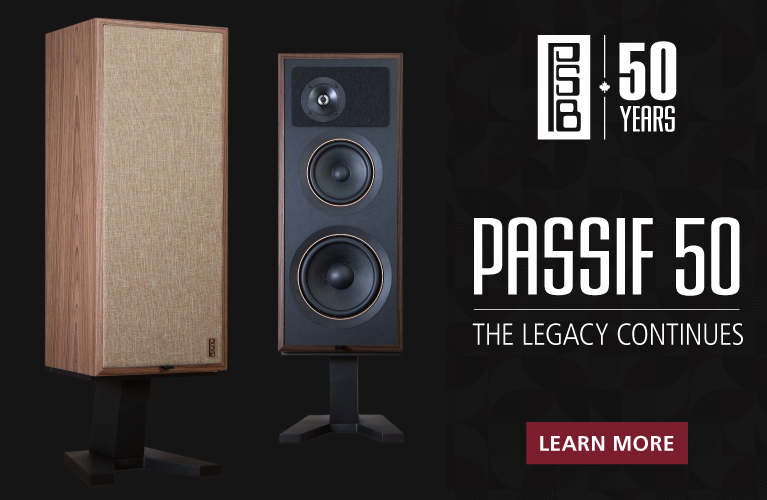 Tubes are big, they run hot, and they’re unreliable -- which is why they’re rare in modern-day electronics. As fun, appealing, and retro an idea as it might seem to have a tubed smartphone, tablet, or laptop, don’t expect it to happen.
Tubes are big, they run hot, and they’re unreliable -- which is why they’re rare in modern-day electronics. As fun, appealing, and retro an idea as it might seem to have a tubed smartphone, tablet, or laptop, don’t expect it to happen.
But there’s one very good reason that tubes still show up in high-end hi-fi gear: sound quality. Implemented well, tubes can have a distinctive sonic character that to many ears, including my own, is nothing short of spectacular, and well worth dealing with their limitations. And after all, that’s what audiophiles are after: sound quality.
Enter JE Audio, a Hong Kong-based maker of tubed electronics that’s small and low-profile enough that you may not have heard of them. But while JEA is small, they make some excellent and affordable components. In May 2011, when I reviewed JE Audio’s VL10.1, I described it as “a reference-class preamplifier at a real-world price.” At the time, it was their top preamp model, and it cost $5000 USD. Now JE Audio has introduced a new flagship preamp: the Reference 1 ($9000).
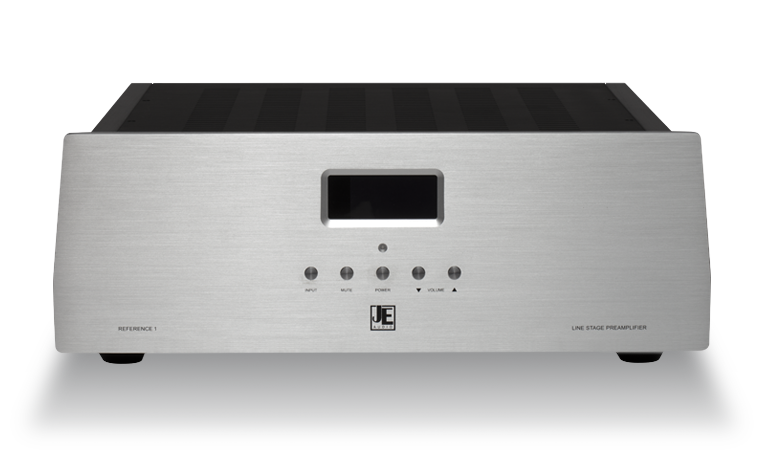
Description
Like the VL10.1, which is still being manufactured, the Reference 1 is a fully balanced, class-A preamplifier that uses no global feedback. It includes JE Audio’s patented Wideband Unity Balanced Amplifier (WUBA) technology, which is claimed to extend the frequency range past 500kHz when the volume control is bypassed. The Reference 1 also has only a single stage of amplification, which, JEA claims, means that it “will have a lower phase shift compared with conventional multi-stage feedback amplifiers.”
The Reference 1 has two 6H30Pi tubes per channel; as each 6H30Pi contains two triodes, that makes a total of four triodes per channel. The VL10.1 has three 6H30Pis per channel, for six triodes per side. Because the Reference 1 has fewer tubes, its gain is lower than the VL10.1’s: 18 vs. 22dB. A gain of 18dB should be more than enough for most systems -- my solid-state reference preamplifier, Simaudio’s Moon Evolution 740P, provides just 9dB and works extremely well in my system.
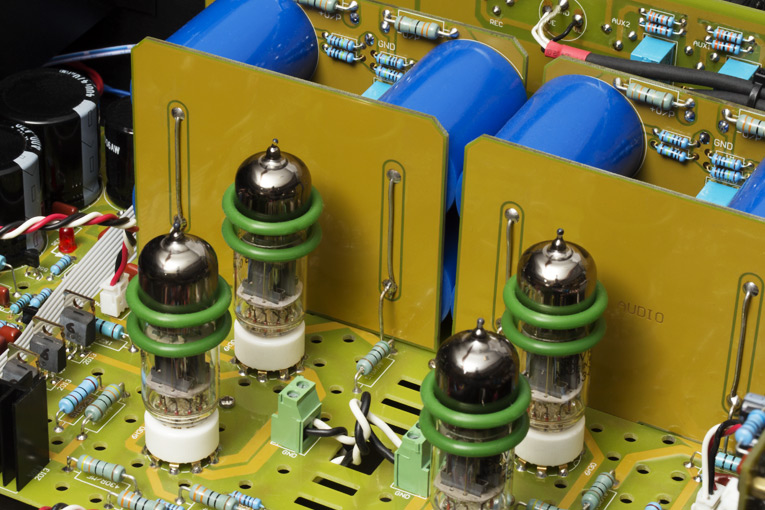
Unlike the VL10.1, which has a conventional volume control, the Reference 1 has a 99-step, digitally controlled potentiometer that JEA claims “attenuates the incoming signals but does not affect the signal integrity.” Nor is the Reference 1 the only JEA product to use a digital volume control. The VL19 preamp, a step below the VL10.1 in JEA’s hierarchy, has one, though of a different design. John Lam, the company’s president and chief designer, told me this about the Reference 1’s volume control:
The VL19 employs a standard audio grade series-type digital volume (potentiometer). The sound is good, but when we developed the Reference 1 preamp, we wanted to design a great-sounding digital volume control. This led us to develop a proprietary shunt-type digital potentiometer. It operates by [the] switching of resistors and it brings very little coloration to the sound. The result reflects in the performance of Reference 1 preamp.
I also learned from Lam that the Reference 1 has a better-designed power supply than the VL10.1, with superior regulation, which, he claims, substantially lowers the preamp’s inherent noise. The Reference 1’s output coupling capacitors are also said to be superior to the VL10.1’s. All of these help to increase the Reference 1’s signal/noise ratio compared to the VL10.1’s.
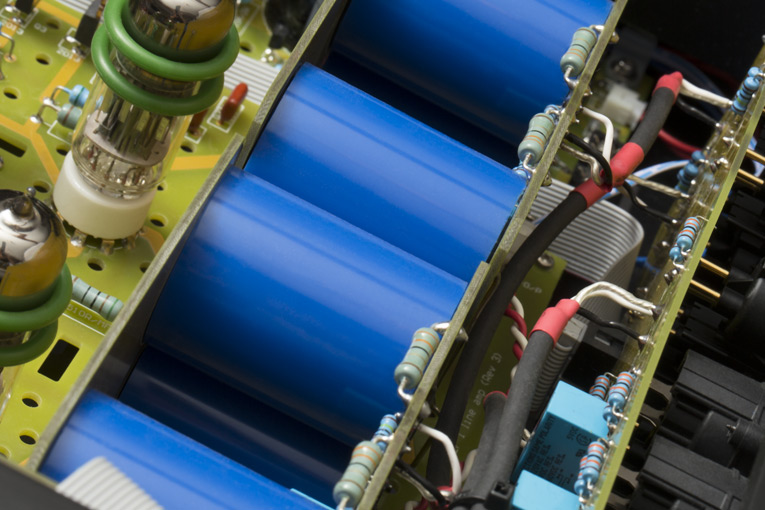
Although the Reference’s circuitry is similar in some ways to the VL10.1’s, in appearance it’s nothing like its predecessor (though it does look a bit like the VL19 and the entry-level VL20 preamps). The Reference 1 actually looks like a smaller version of JEA’s DYAD 400, their top model of stereo power amplifier, with a tubed input stage and a solid-state output stage. Though they don’t have to be used together, the two models were clearly designed to be mates. (I didn’t have a DYAD 400 for this review.)
The Reference 1’s case measures 16.5”W x 6”H (without feet) x 14.5”D, and is finished in matte black. The faceplate is somewhat higher and wider -- 18”W x 6 1/8”H -- and comes in black or silver. As with the DYAD 400, the Reference 1’s faceplate is thicker at the bottom (5/8”) than at the top (3/8”), and must be costly to machine. Also like the DYAD 400, beginning about a third of the way up from the faceplate’s bottom edge, its sides taper inward slightly toward the top. With feet attached, the Reference 1’s total height is 6 7/8”.

Toward the middle of the front panel are five pushbuttons. From left to right, these are: Input, Mute, Power, Volume Down, and Volume Up. Directly above the Power button, a tiny LED glows red when the Reference 1 is plugged in but powered off, and goes dark during operation. Above the LED, a small screen with green characters displays vital information. When the Reference 1 is first turned on, it displays its name and a 40-second countdown as the preamp awakes and warms up its tubes. After that, the Reference 1 is fully powered up: the screen shows the input selected and the volume level, both numerically (“0” to “99”) and as a row of pips running along the bottom of the screen. When the Reference 1 is turned off, before going dark the screen first displays the duration of operation since power-up, in hours and minutes; then the total operating time of the current set of tubes, in hours. The latter is good information to know. Because tubes don’t last nearly as long as transistors, you don’t want to leave tubed components powered up all the time, as you might solid-state gear. JE Audio says that you can expect a set of tubes to last about 3000 hours in the Reference 1.
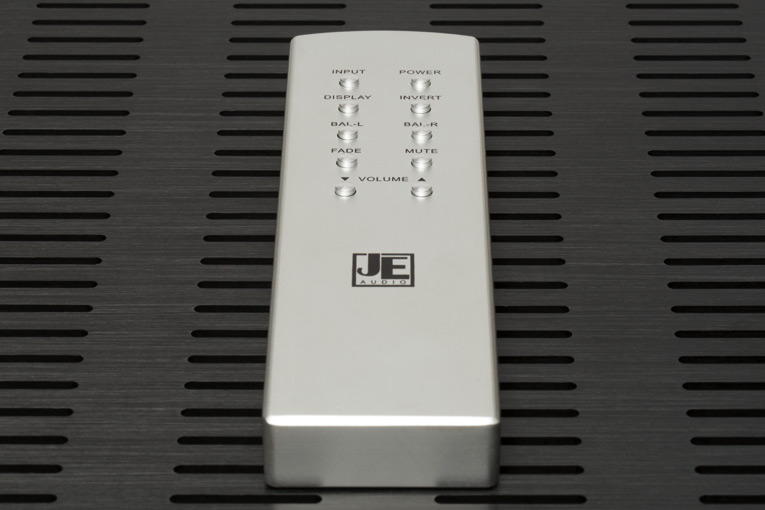
On the cast-aluminum remote control are duplicates of all buttons found on the front panel, and more: Display, to turn the screen on or off; Invert, to flip the polarity (“Invert” pops up on the screen when the polarity has been inverted); Bal-L and Bal-R, to independently adjust the volume of each channel; and Fade, to gently decrease the volume level to “0” (Mute cuts it immediately).
Because the Reference 1 is a fully balanced design, all of its inputs and outputs are balanced, via XLR connectors -- your source components will need to have balanced outputs, and your amp(s) balanced inputs. Also on the rear panel are: six pairs of inputs, labeled CD, Phono, DAC, Tuner, Aux 1, and Aux 2; one pair of Record outputs; and three pairs of amplifier outputs. The last seem excessive, but will be handy for those who want to triamplify. There’s also an IEC-compatible power-cord inlet, but no master power switch.
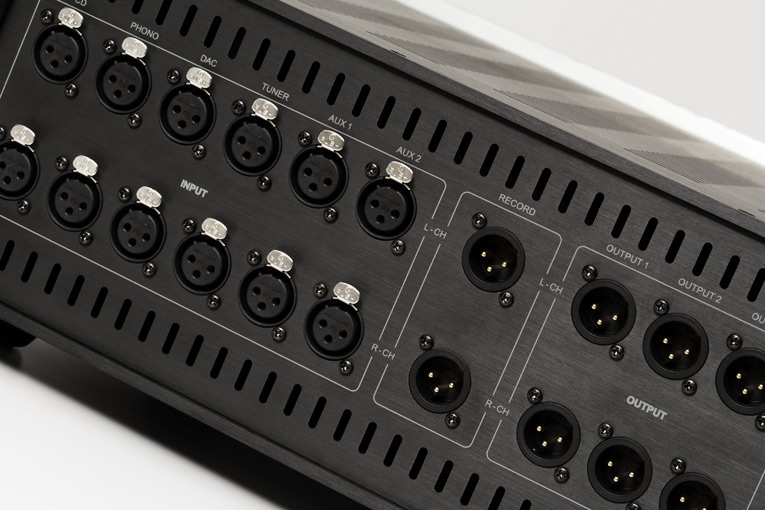
Like JE Audio’s other components -- including the VM60 monoblocks, which I reviewed and still have on hand in my listening room -- the Reference 1 is very well built. And it weighs 32 pounds -- pretty heavy for a preamp. The finishwork is topflight, and the joins between panels superb. The warranty is the same as for JEA’s other products: three years on the preamp itself, provided you register your unit with JEA (otherwise, one year); and 90 days for the tubes.
Setup
Since the Reference 1 was here for a while, it saw time with numerous loudspeakers I’m very familiar with. But for my final listening, and the crux of this review, I used it with Crystal Cable’s Arabesque Minissimos, which I reviewed, and Focal’s Sopra No2 (review in the works). Both speakers cost about $13,000/pair.
Throughout my listening, the wiring remained the same: AudioQuest Carbon USB, Crystal Cable CrystalConnect Standard Diamond interconnects, and Siltech Classic Anniversary 330L speaker cables. For most of my listening I used Simaudio’s Moon Evolution 870A stereo amplifier and 650D transport-DAC, the latter connected to my Samsung laptop running Windows 7 and JRiver Media Center 20. The only thing that changed were the amps, and then only for the Minissimos. The Crystal speakers’ high impedance made them an exceptional match for JE Audio’s VM60 monoblocks. But the VM60s weren’t as good a match for the Focals, so I used the Simaudio 870A throughout my time with those speakers.
My current reference preamplifier, Simaudio’s Moon Evolution 740P, is a solid-state design loaded with features ($9500). I now also have the optional Moon Evolution 820S external power supply ($8000), which can be used to simultaneously power the 740P and 650D and improve the measured performance of both, mostly by producing less noise than do the products’ own power supplies, especially as they’re housed in the same enclosure as the audio circuitry. Also on hand was the sample of JEA’s VL10.1 I reviewed four years ago.
Sound
That the Reference 1 produced less noise than the VL10.1 was obvious even before I played any music. Whereas I could hear the hiss of the VL10.1’s tubes and circuitry when standing a couple feet away from either speaker’s tweeter, with the Reference 1 in the system I had to be within a foot -- not as quiet as the best solid-state preamps, such as the Simaudio 740P, but wholly acceptable for a tubed design. That’s not the most important thing in the world -- even the VL10.1’s hiss is inaudible when music is playing at a normal volume level -- but it’s welcome: the Reference 1 costs almost twice as much.
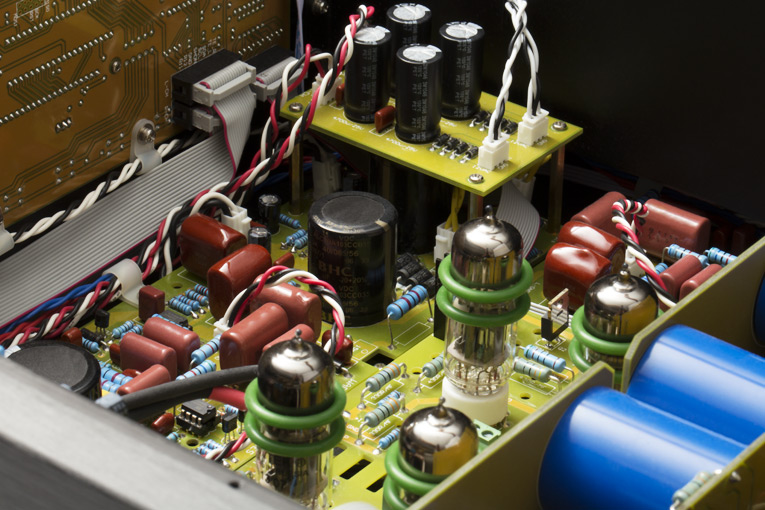
More relevant to me was the increased presence in the mids, greater force and weight in the bass, sweeter highs, and higher resolution. When I played “Song of Me and You,” the simple, spare opening track of Adam Cohen’s We Go Home (16-bit/44.1.kHz FLAC, Rezolute Music), I was taken with how full and natural his voice sounded, how incisive but smooth his guitar was presented, and how much detail I could hear. I was also struck by the improvement in the low end -- the kick drum, which is subtle on this track, had real heft and weight, particularly through the Focal Sopra No2s, which can output copious bass.
Petra Magoni and Ferruccio Spinetti are the singer and double bassist who comprise the Italian duo Musica Nuda, and whom I discovered when I visited the Sonus Faber factory in Italy a few years ago. In their cover of the Police’s “Roxanne” on Musica Nuda (16/44.1, BHM), Magoni’s voice sounded exceptionally full through the Reference 1, but still clear, smooth, and natural; Spinetti’s thick, powerful bass sound was robust and startlingly real, and especially through the Focals. “The Blower’s Daughter,” from Damien Rice’s O (16/44.1 FLAC, Vector), is mixed very “hot,” which can be annoying: Its highs are prominent, with quite a bit of sibilance in Rice’s voice. The Reference 1 didn’t mask these things, but it didn’t exacerbate them; more important, the touch of warmth in the Reference 1’s sound seemed to take the edge off this recording and make it much more palatable to my ears.
One of the things I’ve always loved about the VL10.1 is its ability to cast a wide, deep soundstage -- it makes recordings that have preserved a credible soundstage sound gloriously superspacious. In this area, too, the Reference 1 didn’t disappoint -- its soundstages were as wide and deep as the VL10.1’s -- but it one-upped the VL10.1 in image specificity on those stages; its images being much more precisely delineated and holographic. When I played “Mining for Gold,” from the Cowboy Junkies’ The Trinity Session (16/44.1 FLAC, RCA), Margo Timmins’s voice hung with laser-like focus and palpability at the center of the stage, with each accompanying instrument positioned tangibly in its own space at a realistic distance from her. I’ve visited the space in which this recording was made -- Toronto’s Church of the Holy Trinity -- and have talked at length with Peter J. Moore, its producer and engineer, about exactly how he did it. My feeling, based on what Moore told me and on my visit, is that the Reference 1 very accurately reproduced his recording in my room. And in Musica Nuda’s “Roxanne,” the positions of Magoni and Spinetti were as precise as I’ve heard: she toward the front, dead center; he a bit behind, just to one side; and each occupying her or his space with authentic and tangible presence. Both recordings sounded spookily real.
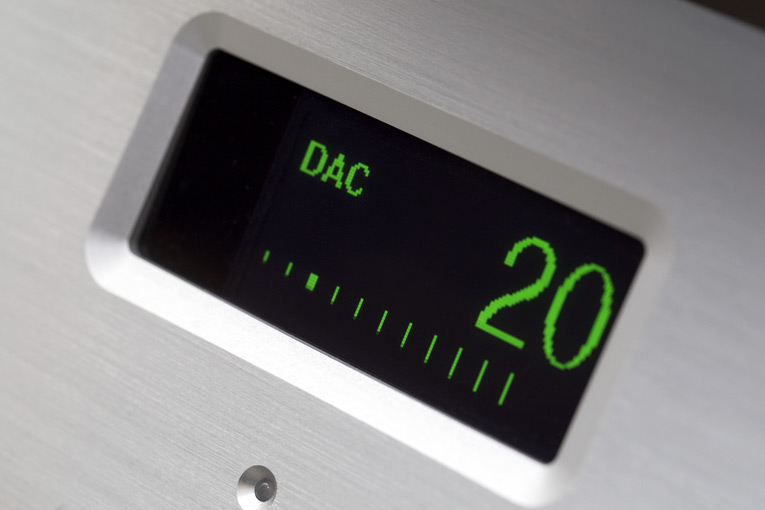
The sounds of the Reference 1 and VL10.1 were certainly cut from the same cloth, with the Reference 1 a bit better in most ways -- lower noise, greater presence, firmer bass, sweeter highs, better image specificity. What was more surprising was what happened when I pitted the Reference 1 against the Simaudio Moon Evolution 740P, itself a first-class preamp.
Though the Reference 1’s noise level was lower than the VL10.1’s, it was still far noisier in my system than the 740P, which presents dead-silent backdrops -- I have to place an ear right next to a tweeter to hear any hiss at all, and even that drops slightly when I use the 820S power supply. The 740P’s virtual absence from the sound of the music makes possible its reference-caliber resolution, and makes it a superb reviewing tool. But where the Reference 1 more than held its own was where it counts most: sound. And comparing its sound with that of the Simaudio 740P was interesting and surprising.
I’ve said many times that the Moon Evolution 740P is so transparent that it has virtually no definable sound -- it’s as if it’s not there at all. This, of course, lets me hear what the other components in my system are doing to the sound. But every time the Reference 1 was part of my system, I could tell that it was there -- not only because of the small increase in noise when no music was playing, but because of the increased fullness, presence, and musical texture it presented music with. The Reference 1 definitely had a sound of its own.
But I really liked what I heard from the Reference 1. This became apparent when I played some recordings of solo acoustic piano while reviewing Crystal Cable’s Arabesque Minissimos, and marveled at how clearly and cleanly those tiny speakers could reproduce the instrument -- the best I’ve heard from so small a speaker. Valentina Lisitsa’s disc of études by Chopin and Schumann (16/44.1 FLAC, Decca) sounded stupendously clean and clear through the Simaudio 740P and the Crystals. When I swapped out the 740P for the Reference 1, the sound was still comparably clean, but the tone was now a little warmer and fuller, and the overall sound was just a bit more realistic and inviting -- so inviting that I didn’t want to stop listening. It sounded great. I then replaced the Simaudio 870A with JE Audio’s VM60 monos, which cost a fraction of the 870A’s price. Holy moley, did that ever sound good -- bell-like clarity combined with a richness of tone that made the Simaudio duo sound a tad thin, sterile, and boring by comparison. Tubes won the day, at least in that setup -- and for a lot less money.
Acoustic piano wasn’t the only thing that sounded better. As clearly, cleanly, and transparently as the 740P reproduced voices, I found the subtle lushness and fullness that the Reference 1 imparted to the voices of some of my favorite singers, male and female, more pleasing overall, not to mention a touch more realistic and natural. Through the Reference 1, plucked guitar notes had a little more body and shimmer than they did through the 740P. And well-recorded cymbals that sounded clean, clean, clean through the Simaudio were just as clean through the JE Audio -- but now with a little more shimmer.
While both preamps laid out soundstages of comparable width and depth, images on those stages had more tangibility and presence through the Reference 1. My experience here mirrored that of Pete Roth, as described in his April 2011 review of the tubed Audio Research Reference 5 preamplifier ($12,000), which he compared with his solid-state Ayre Acoustics KX-R ($18,500): “The Ref 5’s trump card . . . was its sublime superiority of soundstage re-creation. While both components threw a solid, stable soundfield, the depth of focus projected by the Ref 5 could be startling. Fully dimensional images, as opposed to the KX-R’s more elliptical presentation, painted a more realistic and immersive picture.” Ditto for me with, respectively, the Reference 1 and 740P.
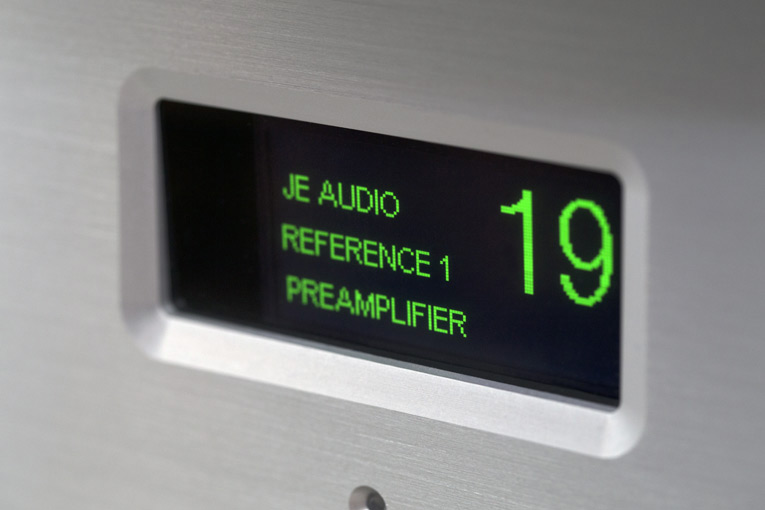
For resolution, my nod goes to the 740P, even without the 820S power supply -- and a somewhat deeper nod with the 820S. But the Reference 1 still revealed a lot of detail, and got closer to the 740P’s resolution than I’d thought any tubed preamp could. In short, when listening through the Reference 1, I never felt I was missing much.
Issues of sound quality aside, the Reference 1 fell short in some ways. Its 99-step range of volume adjustment is good, but can’t match the Simaudio Moon Evolution 740P, which has one of the best volume controls in existence: 530 steps, tunable in increments as fine as 0.1dB, to let you set just the right level. With the 740P, you can also set a different maximum volume for each input, so that someone -- or you -- can’t carelessly crank up the volume, then switch to another source and blow up your speakers. The 740P also lets you independently adjust the levels of the inputs, so that everything plays at about the same level when you’re switching among sources. And I like that you can turn off any unused inputs -- then, when you cycle through them with repeated pressings of the 740P’s Input button, you’re presented with only the active inputs. The 740P also has balanced and single-ended inputs, which might sway those who have single-ended sources. (On the other hand, the 740P has only two sets of balanced inputs and three sets of unbalanced inputs; if you need more balanced ins, that might incline you toward the JE Audio.)
There’s one last thing, something that can make all the difference in the world in choosing a preamp: maintenance. While I had to worry about the lifespan of the Reference 1’s tubes, the 740P’s transistors have never crossed my mind. In fact, one time I left the 740P fully powered up for seven days straight. I never thought twice about it. I’d never do that with the Reference 1, or with any tubed component.
Conclusion
The audiophile who prefers tubed gear doesn’t mind a life that’s not free of trouble. Such people understand that tubes will wear out, sooner than later, and will have to be replaced. But if you don’t want to be bothered with such things, a great solid-state preamp, such as Simaudio’s Moon Evolution 740P, will better suit you.
But if what you’re looking for, first and foremost, is great sound -- specifically, great tube sound -- give JE Audio’s Reference 1 a serious audition. It’s an incredibly good preamplifier for a reasonable price. Its build quality is excellent, its feature set very good, and its sound is out of this world. It’s my top recommendation for preamplifier pleasure for under ten grand.
. . . Doug Schneider
das@soundstagenetwork.com
Associated Equipment
- Speakers -- Crystal Cable Arabesque Minissimo, Focal Sopra No2, GoldenEar Technology Triton One, PSB Imagine T3
- Preamplifiers -- JE Audio VL10.1, Simaudio Moon Evolution 740P
- Amplifiers -- JE Audio VM60 monos, Simaudio Moon Evolution 870A
- Digital-to-analog converter -- Simaudio Moon Evolution 650D
- Power supply -- Simaudio Moon Evolution 820S
- Computer -- Samsung laptop running Windows 7 and JRiver Media Center 20
- Speaker cables -- Siltech Classic Anniversary 330L
- Analog interconnects -- Crystal Cable CrystalConnect Standard Diamond
- Digital interconnect -- AudioQuest Carbon USB
JE Audio Reference 1 Preamplifier
Price: $9000 USD.
Warranty: Three years parts and labor; 90 days, tubes.
JE Audio
Unit L, 5/F, Block 1
International Industrial Center
2-8 Kwei Tei Street
Fotan, Shatin
Hong Kong
Phone: (852) 3543-0973
Fax: (852) 3543-0971
Website: www.je-audio.com






















